Meet “Rooipens skilpad,” otherwise known as the angulate tortoise, also known as the bowsprit tortoise.
Running among the coastal scrub vegetation of South Africa is a very interesting tortoise species called the angulate tortoise (Chersina angulata). Locals refer to it as “Rooipens skilpad,” meaning “red-belly tortoise” in the West Germanic language, Afrikaans.
Now I know what you’re thinking: Did he just use the word running while describing a tortoise? Well, you read that correctly, my friends, because this tortoise actually darts and scurries in and out of vegetation across its range. It’s really rather surprising just how quick these animals are! They exhibit an attentive personality with seemingly nervous movements as they bob their little heads from side to side to check out their surroundings or during courtship.
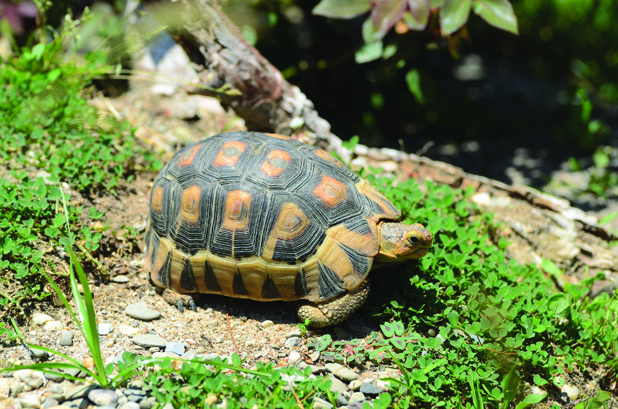
Chris Leone
Chersina angulata may comprise one of the densest tortoise populations in nature.
Chersina angulata is the most common tortoise species found in South Africa, with locals and tourists alike reporting sightings of tortoises along the coastal landscapes of its range. And although Rooipens skilpad appears to be thriving in nature, the angulate tortoise has become known in the tortoise-keeping hobby as being a difficult species to keep in captivity, with very minimal breeding success. It is, indeed, a challenging, rare chelonian in the U.S., but when available, it can make a remarkable and truly rewarding addition when kept in a proper setting.
Angulate Tortoise IUCN Status
The angulate tortoise is currently listed as “least concern” on the IUCN Red List of Threatened Species, being described as abundant with up to 34 tortoises found in its natural habitat per hectare. This may be one of the densest tortoise populations occurring in nature.
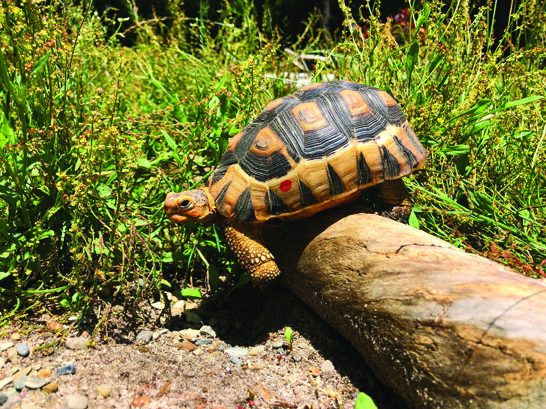
Chris Leone
Though common in its native habitat, the angulate tortoise is rare in collections.
Chersina angulata is found throughout South Africa to Namibia and also occurs on several islands including Dassen Island, where its density is considered to be the highest. It inhabits semi-arid coastal expanses with a Mediterranean climate.
While the angulate tortoise may not be an endangered chelonian species (for now), it certainly is one of the most unique. The egg-shaped carapace is nearly pitch black, with the center of each scute orange or yellow. The carapace also has a noticeable arch to it and is raised in the posterior with varying levels of flaring at the rear. Dark shapes contrast with a light ground color on the marginal scutes. The entire carapace of extremely old specimens often turns a dull yellow to brown coloration. The plastron features dark pigment surrounded by red, yellow or orange coloration.
The angulate tortoise goes by another name: the “bowsprit tortoise.” A bowsprit is a spar that extends from the bow of a sailing ship; C. angulata comes by this name due to its well-known gular projection, found on the plastron just under the tortoise’s neck. It is particularly prominent on males, who use it for jousting. Rather than having two gular scutes on the plastron like all other African species, Rooipens skilpad has only one, and it protrudes forward into the bowsprit. The projection is impressive, seeming almost disproportionate to the tortoise’s body. At times it can appear as though it’s nearly impossible for the animal to withdraw its head and neck. Fear not, however, for the bowsprit tortoise is perfectly capable of doing so because they possess a small, narrow head and thin neck (and lanky limbs, too).
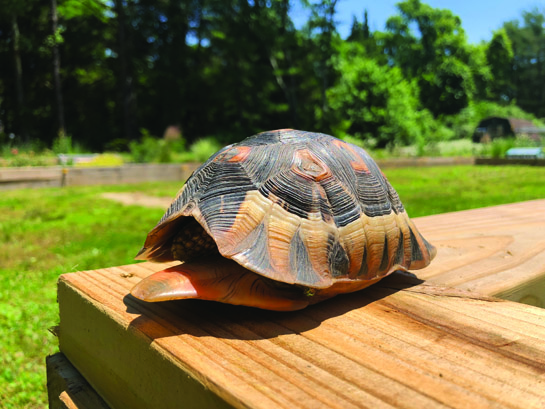
Chris Leone
Note the gular projection by which the angulate tortoise comes by its other common name of “bowsprit tortoise.”
Male angulate tortoises are relentless warriors. They will sometimes battle each other to the death over females as they attempt to use their bowsprits to overturn each other. An overturned tortoise that is unable to right itself will inevitably cook in the unforgiving South African sun. Female C. angulata can be differentiated from males by their less-conspicuous bowsprit; a flat plastron (males’ are concave); a smaller, stouter tail and a rounder body shape that’s thicker at the mid section.
The angulate tortoise is a single species with no currently recognized subspecies; however, color and size variations do exist. Tortoises in the western part of the species’ range often have plastrons that are more red in color, while darker-colored animals inland may lack this. Chersina angulata occurring in eastern portions of the range are often smaller and more yellow.
Overall, adults may reach sizes of 7½ to 8 inches for females, with larger males making it to 10 inches (some sources report specimens reaching as much as 12 to 13 inches). Hatchlings bear concentric rings on each scute and exhibit a white ground color. As they grow, they develop the adult coloration and shape.
Angulate Tortoise Outdoor Environment
Chersina angulata is uncommon in the American reptile trade and has made only isolated appearances throughout the years on dealer lists. Small importations of adults or sub-adults have come in from overseas, fetching high prices of between $1,500 and $2,500 for a single animal. Unfortunately, most do not survive long term, succumbing to typical reptile health and wellness issues like respiratory infections and shell/skin rot. This is primarily due to inappropriate housing conditions or poor transportation methods.
How To Build A Basic Outdoor Tortoise Pen
The angulate tortoise is a semi-arid species that is most comfortable on reptile substrates like sand, that have low-lying shrubbery and abundant sunshine. Like any tortoise species it enjoys warmth but needs protection from the sun. It is also sensitive to feeling exposed, and although a smaller species, needs ample space.
Given the proper care, individuals have proven to thrive both indoors and out in various regions of the U.S. In southern coastal New Jersey, we have had success housing angulate tortoises indoors for winter and outdoors in naturalistic enclosures for the summer. Depending on the weather patterns and temperatures in a given year, they are able to go outside sometime in May and come back inside in early to mid-October. Temperatures should not be falling below 70 degrees Fahrenheit during the day or below 50 at night when they are to be put out for the season. Sunny days are paramount; prolonged periods of rainy, cool weather with thick cloud cover should be avoided.
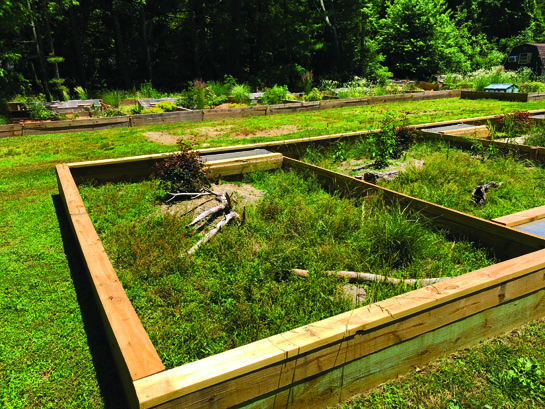
CHRIS LEONE
One of the author’s outdoor pens that houses Chersina angulata.
It’s worth noting that one of the challenges when keeping this species is the inability to house males together. They are far too aggressive and will constantly fight each other, with the dominant male forcing any others into hiding. This can lead to the subordinate tortoises suffering from dehydration and emaciation from being unable to feed. Even the dominant male may suffer because his sole interest will be to fight and not to eat or drink.
In nature, the tortoises can easily escape each other, but in confined reptile habitats, they can’t; therefore, it is best to house males individually. Females generally do well in groups, and more often than not, at least one male can live with them. He may be persistent as he gapes his mouth, emits squeaking sounds and attempts to mount, so keep a close watch to be sure he is not stressing out the females.
An outdoor enclosure measuring 20 by 10 feet will comfortably house one male and up to five females. The walls can be made from pressure-treated planks and should be 18 to 24 inches tall. Angulate tortoises don’t burrow much, so the walls only need to be dug into the ground about 4 inches. The enclosure must be located in an area completely free of any flooding or pooling and should be in full sun.
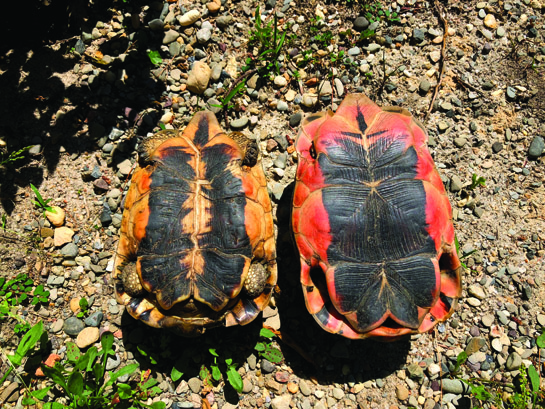
chris leone
You can see why C. angulata is known locally as “Rooipens skilpad,” which means “red-belly tortoise” in Afrikaans.
In our coastal location, we have a naturally reptile sandy substrate that works well as a substrate for many tortoise species, including C. angulata. A grass lawn would need to be removed and replaced with a substrate comprised of sand, top soil and some gravel. It’s crucial for the substrate to drain well and replicate the semi-arid native environment these tortoises thrive in. Uneven terrain within the enclosure should be provided by creating mounds and slopes. You can never go too far when it comes to reptile accessories in the habitat. Sun-bleached tree limbs, driftwood, river stone, flag stone and small to medium boulders can be added for aesthetic appeal and as visual barriers that will help curb potential stress.
Plant life is important for this species in offering refuge. Mediterranean Heather, Spiraea, hibiscus, fountain grass and knockout rose are beautiful, safe choices. Allowing edibles to grow throughout the enclosure enables the tortoises to graze at their leisure. Clover, plantain, vetch, sow thistle, black medic, hens and chicks, and sedum are recommended.
Shallow water dishes (like the Exo Terra Reptile Water Dishes) that are 1 to 2 inches deep should be recessed into the ground. Both terra cotta saucers and stainless steel dog food pans work well. A small green house or cold frame can be installed in the enclosure to allow the tortoises to thermoregulate on less than desirable days. Here in the northeast, we have found them to be very beneficial and help to keep our tortoises outside a little longer during the year. Chersina angulata can handle temperatures as low as 45 degrees, but only for brief periods. This is more acceptable during the night as long as daytime temperatures rise back up into at least the low 70s. Maintaining reptile heating and lighting is crucial for many species, including tortoises.
Angulate Tortoise Indoor Habitats
Kept indoors, angulate tortoises often do best when housed individually regardless of sex. Because they are an active species that appreciates being able to move quickly from place to place, they are able to do so without stressing each other out if kept singly.
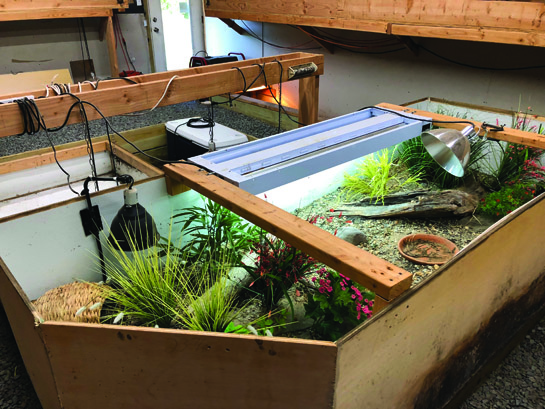
Chris Leone
A proper indoor enclosure for C. angulata.
An enclosure measuring 4 by 2 feet can house a single tortoise. A larger indoor unit that’s at least 8 by 4 feet can house two to three females together. Males, of course, must be separated. “Tortoise table” enclosures made from plywood or other material, large Rubbermaid totes and custom reptile caging all can work for an indoor set up.
For indoor substrate, we prefer to use a 50/50 mix of organic top soil and crushed oyster shell with a few splashes of sand added. Artificial or live plants can be used, including various succulents such as agave and aloe. Cork bark, half-log huts (Zoo Med Habba Hut), driftwood, rocks and other decor should be placed randomly throughout the enclosure. We also offer areas of straw and/or timothy hay for additional cover.
Terra cotta saucers should be utilized for both food and water dishes. For lighting, strong UVB is needed to replicate the pressing sunshine of the angulate tortoise’s natural habitat. I recommend Exo Terra’s Solar Glo All In One Reptile Lamp. A basking area reaching a desired temperature of between 95 and 105 degrees can be achieved by using a simple indoor/outdoor 100-watt light Fluker’s Sun Dome fixture placed at one end over a piece of flagstone. No nighttime heat is required for this tortoise, as it normally experiences cooler temperatures in nature once the sun descends. It can get quite chilly until morning. You can use the Zilla Terrarium Heat & Habitat Lighting Controller along with reptile thermometers to monitor your temps.
Chances are captive angulate tortoises will be housed indoors for the winter in the U.S., and this is a good time to replicate artificial rains resembling the weather in South Africa. Use a mister to spray down the entire enclosure two or three times a week. Be sure to not overdo it, though, as a wet or constantly damp substrate will result in illness over time.
Like any tortoise species, C. angulata is susceptible to dehydration and hatchling failure when very young. I recommend housing youngsters indoors for several years in reptile enclosures such as those manufactured by Herp Cages and Vision Cages. These allow proper humidity of 65 to 75 percent, but also allow ventilation. You can monitor this with humidity hygrometers. The setup can mimic the adult indoor enclosure previously described, but be sure to keep the substrate moist. Baby tortoises need moisture in a microclimate; this enables them to grow smooth (avoid pyramiding) and stay hydrated. Water should also always be available in small terra cotta saucers.
Angulate Tortoise Food
Our angulate tortoises do well, and have even bred successfully, when provided the following food items.
All Sedum succulents are safe to feed, with the exception of S. acre, S. frutescens and S. morganianum. Weeds including clover, plantain, cat’s ear, sow thistle, vetch and black medic are excellent food items, along with opuntia cactus and hibiscus leaves/flowers. Store-bought produce can be offered in moderation; raddichio, escarole, dandelion and spring mix are some of the better choices.
Fruits and vegetables should only be offered occasionally because sugar is not a recommended component of C. angulata’s diet. Squashes, sweet potato and green beans are favored, though infrequent, “treat” items for our tortoises.
Rather than dusting food items with calcium powder, we opt to use cuttlefish bone strewn about the enclosures, which the tortoises nibble on when they see fit. You can also supplement from time to time with Mazuri tortoise food products for added nutrition.
Angulate Tortoise Breeding Trials and Tribulations
Our adult female angulate tortoises have frequently laid eggs over the past several years but none ever hatched successfully. Similar to their behavior in the wild, they typically lay from September to April and deposit one egg per clutch, up to six times yearly. Eggs are always deposited in the evening (sometimes into the night) in shallow nests dug into the substrate of a recessed plastic sweater box containing a mix of top soil, crushed oyster shell, mason sand and organic potting mix.
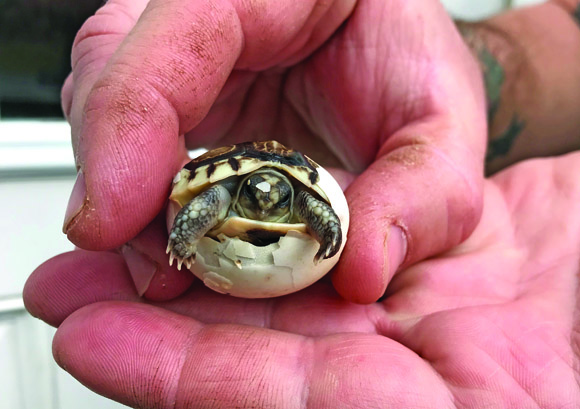
Chris leone
Angulate tortoise hatchling.
Males are housed with females only for short breeding periods; because of their tireless attempts, these last only for a week or so before they’re separated again. Sometimes males will be placed together briefly to allow for competition as stimulation. Within minutes they are ready to battle, and this helps to reinvigorate males that may have become lethargic and uninterested in breeding.
We have had eggs begin to develop using straightforward incubation methods, only to have the embryos perish inside the eggs prior to hatching. This is a common issue reported by C. angulata keepers worldwide.
Eggs maintained on slightly moist vermiculite (5:1 ratio of vermiculite to water by weight) in perforated deli containers developed normally for 61 to 93 days, but then died. We experimented with incubation temperatures ranging between 83 and 90 degrees, with humidity between 70 and 80 percent. One egg fooled us into believing it had hatched; it was actually dead, and whether or not the baby had pipped and then died or the egg began to decompose, pushing the dead baby out, remains a mystery to us.
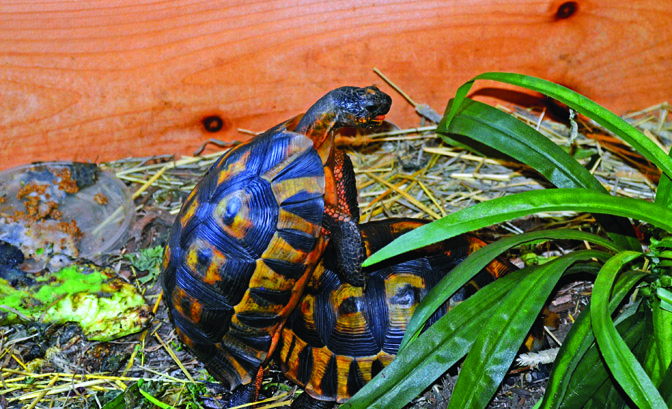
CHRIS LEONE
A pair of the author’s tortoises breeding inside an indoor enclosure.
We eventually tried providing a cooling period for the eggs, much like we do for our Burmese star tortoise (Geochelone platynota) eggs. The angulated eggs were kept on very slightly moistened vermiculite, again in deli containers, but between 65 and 68 degrees for 30 days immediately after being laid. After 30 days, the incubation temperatures and humidity levels were raised to those previously mentioned. Only one egg developed, for about two weeks, before it began to decompose.
We tried the same method with another four eggs. Three never developed and were discarded, while one remained in a torpor of sorts. It chalked and revealed one small blood vessel. This egg was removed from incubation after three weeks, placed back into cooling for two additional weeks, and then placed back into incubation. It developed up until about 90 days, when a nearly fully developed hatchling perished inside the egg.
With the next two eggs our females’ provided, we tried straight incubation on dry perlite at 84 degrees with 70 percent air humidity in an open-top container inside the incubator. One egg proved to be infertile while the other developed for 65 days. Then, yet again, the embryo perished inside the egg.
At this point I began reaching out for suggestions more than ever, especially after joining the newly formed Chersina angulata Working Group founded by Dan Sterantino. I received several opinions as to how to hatch this difficult species, some from people who experienced dumb luck with extremely limited success, as well as others who could explain exactly what they did.
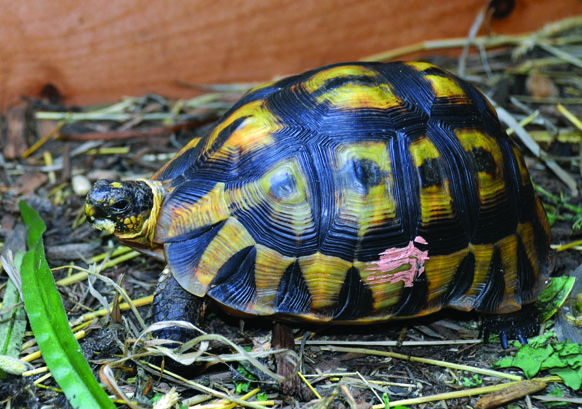
Chris Leone
It is hoped that C. angulata is bred in captivity with increasing frequency in the years ahead.
On December 22, 2017, I unearthed one egg. The temperature inside our tortoise building that morning was only 55 degrees, which had been typical for the past several weeks. We allow the nighttime drop in our building because it promotes breeding activity for other species we keep in there, including our Egyptian tortoise (Testudo kleinmanni) colonies. The cool nights and mornings, followed by a significant rise in heat during the day, replicate some of the coastal expanses that Egyptian and angulate tortoises experience in nature. It’s proven to be a great way to promote breeding and the production of fertile eggs throughout winter and early spring.
Upon inspecting this new egg, I noticed it had already chalked and had one tiny blood vessel in it. Knowing others, including chelonian keeper Kingsley Rodrigo and the Turtle Conservancy, had hatched angulate tortoise eggs by allowing a nighttime drop in incubation temps, I decided to give this a try.
I placed the egg in an open-top deli container, on substrate from the enclosure (the previously mentioned mix of top soil, crushed oyster shell, mason sand and organic potting mix). The temperature in the incubator, which was a simple Styrofoam Hovabator used for chicken eggs, was set to 86 degrees. The incubator was hooked up to a timer that would turn on at 7:22 a.m. and off at 10:22 p.m. Each night, the temperature would drop down to between 65 and 68 degrees and then rise back up rather quickly when the timer turned the incubator on in the morning.
During the day, the humidity inside the incubator would drop as low as 53 to 61 percent, only to rise at night, sometimes up to 85 percent. I allowed for fluctuation, which is, of course, what eggs would experience in the wild. I added a little bit of water to the egg’s substrate only when the nighttime humidity dropped below 70 percent.
I also sanded down the egg shell, based on advice I was given by U.S. chelonian keepers Austin Miller and Max McGlasson. This had been done to successfully hatch Galapagos tortoises (Chelonoidis nigra) and Guerrero wood turtles (Rhinoclemmys rubida), and because reports of oxygen deprivation with tortoise eggs had surfaced, I went ahead and actually sanded down the egg. Using 600-grit sandpaper, I carefully held the egg on a bedspread and sanded away. It’s difficult to gauge just how much I sanded, but I’d estimate about 50 percent of the egg’s surface became glossy white and very polished looking. I checked the embryo by candling and it was still alive and moving.
Roughly two weeks after sanding and 89 to 95 days of incubation, the egg successfully hatched, and a flawless, robust, baby angulated tortoise entered the world. Dubbed “Ayanda,” which is South African for “they are increasing,” this hatchling was healthy and continues to thrive as of this writing. We will continue to follow the aforementioned incubation protocol for all future eggs we receive from our adult C. angulata.
Angulate Tortoise Future
The world is populated by more than 300 chelonian species, and the angulate tortoise is without a doubt one of the most recognizable. Its interesting habits and occasionally comical behaviors can captivate anyone in seconds. As mentioned, although still a common sight in its South African homeland, C. angulata remains a rarity in captive situations. A general lack of understanding when it comes to husbandry and incubation has, sadly, led to many failures.
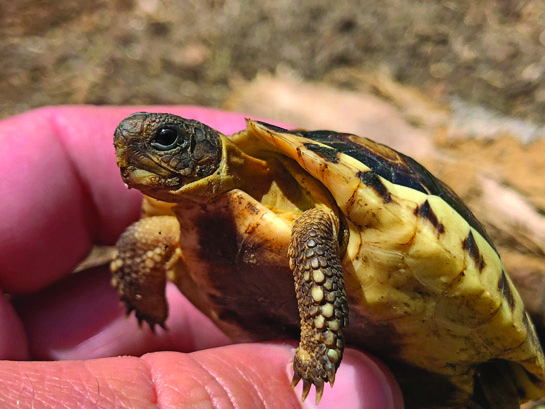
chris leone
“Ayanda” is South African for “they are increasing.”
As an active member of the Chersina angulata Working Group, it is my hope that what I and others have learned through pure trial and error will help future Rooipens skilpad keepers in achieving their own success from the start. Very few angulate tortoises are hatched under human care each year, but with new experiences surfacing we as responsible enthusiasts can work out the kinks and eventually learn the ropes of how to consistently propagate them for years to come. The angulate tortoise is certainly worth keeping if you’re lucky enough to come across it.
And let me tell you, there is nothing like seeing a baby C. angulata hatch and take its first breath. Our little success story of Ayanda is one I’ll tell for as long as I’m able, and the joy of watching this young tortoise grow has been unmatchable.
Chris Leone is the director of animal husbandry for theTurtleRoom and the owner of Garden State Tortoise. His work with turtles and tortoises spans more than three decades. Visit him at GardenStateTortoise.com, HermanniHaven.com and theTurtleRoom.com.


